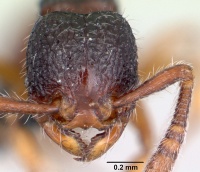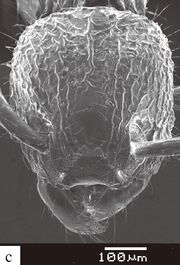Myrmecina guangxiensis
| Myrmecina guangxiensis | |
|---|---|

| |
| Scientific classification | |
| Kingdom: | Animalia |
| Phylum: | Arthropoda |
| Class: | Insecta |
| Order: | Hymenoptera |
| Family: | Formicidae |
| Subfamily: | Myrmicinae |
| Tribe: | Crematogastrini |
| Genus: | Myrmecina |
| Species complex: | vieti |
| Species: | M. guangxiensis |
| Binomial name | |
| Myrmecina guangxiensis Zhou, 2001 | |
Specimens of this ant have been collected from litter samples in forest habitats.
Identification
Okido, Ogata, and Hosoishi (2020) - Myrmecina guangxiensis A member of the Myrmecina vieti complex. The other members of the complex are: Myrmecina nomurai and Myrmecina vieti. Among those species, M. guangxiensis can be distinguished from the remains by having the short and sculptured petiole which is not expanded laterally at the anterior portion in dorsal view, and the mesosoma with the rugae diverging anteriorly. Some morphological variations, such as the smooth and shining clypeus and the more strongly punctured mesosoma, are found in this species.
Zhou (2001) - Resembles Myrmecina taiwana, but differs from the latter in propodeal spines triangular, broad at base, straight backward, not curved upward 1 head much smaller (HL 0.63~0.65, HW 63~63 in the latter); petiolar node much lower and narrower (PL 0.23, PH 0.24~0.25 in the latter).
Keys including this Species
Distribution
Latitudinal Distribution Pattern
Latitudinal Range: 30.115° to 21.9115°.
| North Temperate |
North Subtropical |
Tropical | South Subtropical |
South Temperate |
- Source: AntMaps
Distribution based on Regional Taxon Lists
Oriental Region: Vietnam.
Palaearctic Region: China (type locality).
Distribution based on AntMaps
Distribution based on AntWeb specimens
Check data from AntWeb
Countries Occupied
| Number of countries occupied by this species based on AntWiki Regional Taxon Lists. In general, fewer countries occupied indicates a narrower range, while more countries indicates a more widespread species. |

|
Estimated Abundance
| Relative abundance based on number of AntMaps records per species (this species within the purple bar). Fewer records (to the left) indicates a less abundant/encountered species while more records (to the right) indicates more abundant/encountered species. |

|
Biology
Myrmecina guangxiensis has been collected from leaf litter in rain forest, secondary forest and limestone forest. Okido, Ogata, and Hosoishi (2020) reported this species has ergatogyne queens and that it lives in the soil.
Castes
Worker
Images from AntWeb
   
| |
| Worker. Specimen code casent0070296. Photographer April Nobile, uploaded by California Academy of Sciences. | Owned by CAS, San Francisco, CA, USA. |
Nomenclature
The following information is derived from Barry Bolton's Online Catalogue of the Ants of the World.
- guangxiensis. Myrmecina guangxiensis Zhou, 2001b: 139, 237, figs. 275, 276 (w.) CHINA.
Unless otherwise noted the text for the remainder of this section is reported from the publication that includes the original description.
Description
Worker
Holotype: TL 2.5, HL 0.56, HW 0.55, CI 98, SL 0.46, SI 83, PW 0.40, AL 0.70, PL 0.17, PH 0.17, DPW 0.16, PPH 0.18, PPW 0.22. Paratype: TL 2.6, HL 0.56, HW 0.55, CI 98, SL 0.46, SI 83, PW 0.41, AL 0.72, PL 0.18, PH 0.18, DPW 0.17, PPH 0.20, PPW 0.23.
Head slightly longer than broad, with convex sides and slightly concave occipital border. Anterior clypeal border slightly concave, median tooth low, indistinct. Mandible with apical and preapical teeth, followed by 5-6 indistinct denticles. Antennal scapes not reaching to occipital corners; ratio of length from 8th to 12th segments in: 2 : 2 : 5 : 6 : 19, terminal segment 1.7 X as long as broad. Eyes small, situated in front of the midlength of the sides of head. Promesonotum slightly convex, teeth of anterolateral corners of propodeum low and indistinct, rounded at tip; propodeal spines triangular, broad at base, straight backward and not curved upward.
Mandibles and middle of clypeus smooth and shining; dorsum of head with longitudinal striations in the middle, sides irregularly striate, occipital corners reticulate with large meshes; dorsum of alitrunk with 2 straight longitudinal striations in the middle, laters irregularly striate; petiole and postpetiole shagreen; gaster smooth and shining. Erect hairs abundant, the longest hair on head 0.08mm, on alitrunk 0.12mm, on petiole 0.15mm.
Color reddish brown.
Okido, Ogata, and Hosoishi (2020) - TL 2.22, HL 0.56, HW 0.54, CI 97, SL 0.48, SI 88, PW 0.38, ML 0.59. ergatogyne. TL 2.72, HL 0.61, HW 0.61, CI 100, SL 0.53, SI 87, PW 0.45, ML 0.67.
Head subrectangular, as long as broad in full-face view; median portion of occipital margin almost flattened; occipital corners rounded, not projected posteriorly. Masticatory margin of mandible bent at midlength (third small tooth or sixth tooth); apical tooth strong, third tooth robust, followed by 4-5 small teeth and a stout basal tooth bearing blunt apex. Dorsal surface of clypeus concave; median portion of anterior margin weakly projected without a median process; lateral portion raised into a sharp ridge of shield wall on each side, in front of antennal insertions. Anterior dorsal surface of labrum with paired denticles, fused with each other at base. Frontal carinae present, running back to or beyond the level of the posterior margin of the eyes. Eyes very small, varying in size with maximum diameter 0.06 mm and 4-5 ommatidia. Antennal scape long, extending beyond posterolateral corner of head; antennal flange weakly developed.
Dorsal outline of mesosoma convex in profile. Pronotum without denticles; anterior ventrolateral portion not angulate. Eumetanotal spine present but small. Propodeal spine triangular, directing upward and backward, not reaching vertical posteriormost limit of propodeum in profile; tips directing outward in dorsal view. Propodeal lobe low. Propodeal spiracle large, situated near base of propodeal spine, apart from margin by its diameter. Petiole short; small dorsal crest located slightly at anterior portion in profile; subpetiolar process projecting forward with acute apex. Postpetiole slightly broader than petiole in dorsal view; lateral margin straight and not marginated; dorsal outline flattened in profile; ventral outline projecting forward with small but distinct apex.
Anterior margin of gaster concave in dorsal view.
Head with thin and irregular rugae and punctures weakly, but variable; ventrolateral portion smooth and shining, without rugae. Mandibles with large yellow spots on dorsal surface. Clypeus weakly punctured or smooth and shining. Mesosoma with thick rugae irregularly in profile. Mesosoma with thick rugae wavy and divergent anteriorly (forming “Y”-shape). Petiole and postpetiole with a few longitudinal rugae. First gastral tergum smooth and shining dorsally. Head with sparse pilosity on dorsum. Mesosoma with sparce pilosity on dorsum. Pilosity of pronotum more or less longer than propodeal spines. Pilosity of petiole and postpetiole relatively longer than that of mesosoma. Postpetiole with hairs on ventral surface. Head, mesosoma, petiole and postpetiole varying from reddish brown to black, legs yellowish, forecoxae yellowish brown, gaster reddish brown.
Type Material
Holotype worker, Huashuichong Natural Reserve, Hezhou City, Guangxi, 1.IX.1998, Shanyi Zhou leg. Paratype 1 worker, Da Ping Shan Natural Reserve, 18.IX.1998, John. R. Fellowes leg.
References
- Liu, C., Fischer, G., Hita Garcia, F., Yamane, S., Liu, Q., Peng, Y.Q., Economo, E.P., Guénard, B., Pierce, N.E. 2020. Ants of the Hengduan Mountains: a new altitudinal survey and updated checklist for Yunnan Province highlight an understudied insect biodiversity hotspot. ZooKeys 978, 1–171 (doi:10.3897/zookeys.978.55767).
- Liu, C., Fischer, G., Liu, Q., Peng, Y.-Q., Economo, E. P., Guenard, B. 2022. Updating the taxonomy of the ant genus Myrmecina (Hymenoptera, Formicidae) in China with descriptions of three new species. Zootaxa, 5182(2), 152-164 (doi:10.11646/zootaxa.5182.2.2).
- Liu, C.; Guénard, B.; Hita Garcia, F.; Yamane, S.; Blanchard, B.; Yang, D.-R.; Economo, E. 2015. New records of ant species from Yunnan, China. ZooKeys 477:17-78.
- Okido, H., Ogata, K., Hosoishsi, S. 2020. Taxonomic revision of the ant genus Myrmecina in Southeast Asia (Hymenoptera: Formicidae). Bulletin of the Kyushu University Museum 7, 1-108.
- Zhou, S. 2001. Ants of Guangxi. Guilin, China: Guangxi Normal University Press. 255 pp. (page 139, 237, figs. 275, 276 worker described)
- Zhou, S., Huang, J., Ma, L. 2008. Two new species of the ant genus Myrmecina (Hymenoptera: Formicidae), with a key to Chinese species. Sociobiology. 52: 283-291.
References based on Global Ant Biodiversity Informatics
- Fontanilla A. M., A. Nakamura, Z. Xu, M. Cao, R. L. Kitching, Y. Tang, and C. J. Burwell. 2019. Taxonomic and functional ant diversity along tropical, subtropical, and subalpine elevational transects in southwest China. Insects 10, 128; doi:10.3390/insects10050128
- Guénard B., and R. R. Dunn. 2012. A checklist of the ants of China. Zootaxa 3558: 1-77.
- Liu C, B. Guénard, F Hita Garcia, S. Yamane, B. Blanchard, and E. Economo. New records of ant species from Yunnan, China. Submitted to Zookeys
- Zhou Shanyi, Jianhua Huang, and Libin Ma. 2008. Two new species of the ant genus Myrmecina (Hymenoptera; Formicidae), with a key to chinense species. Sociobiology 52(2): 283-291.



